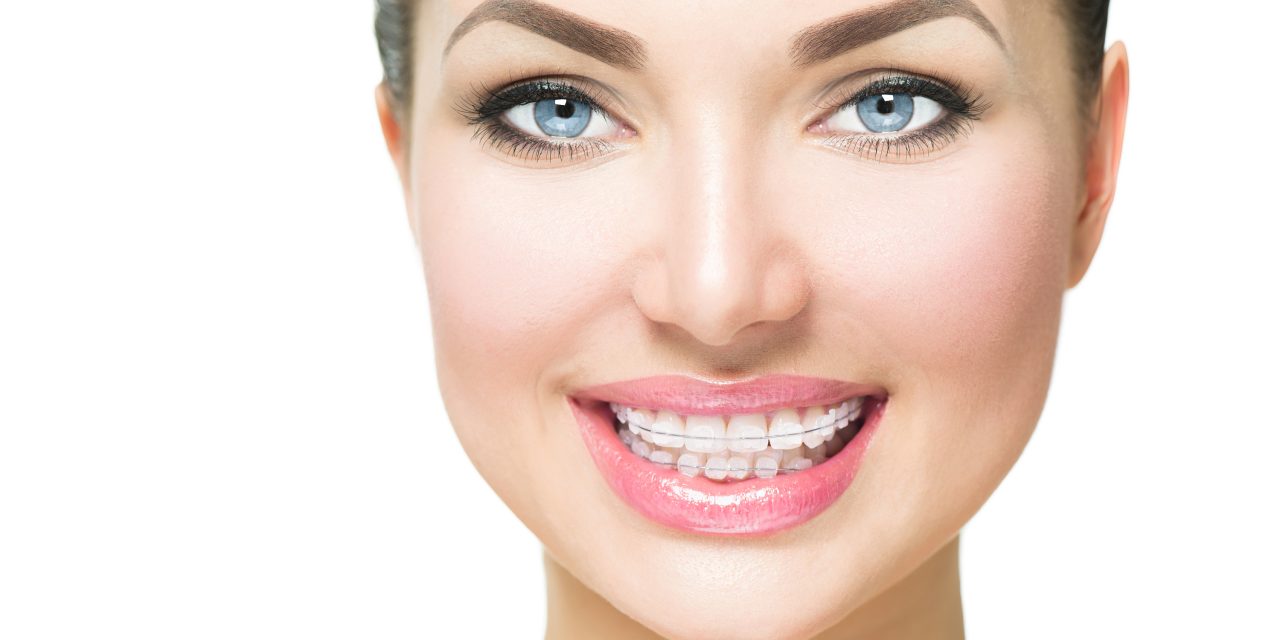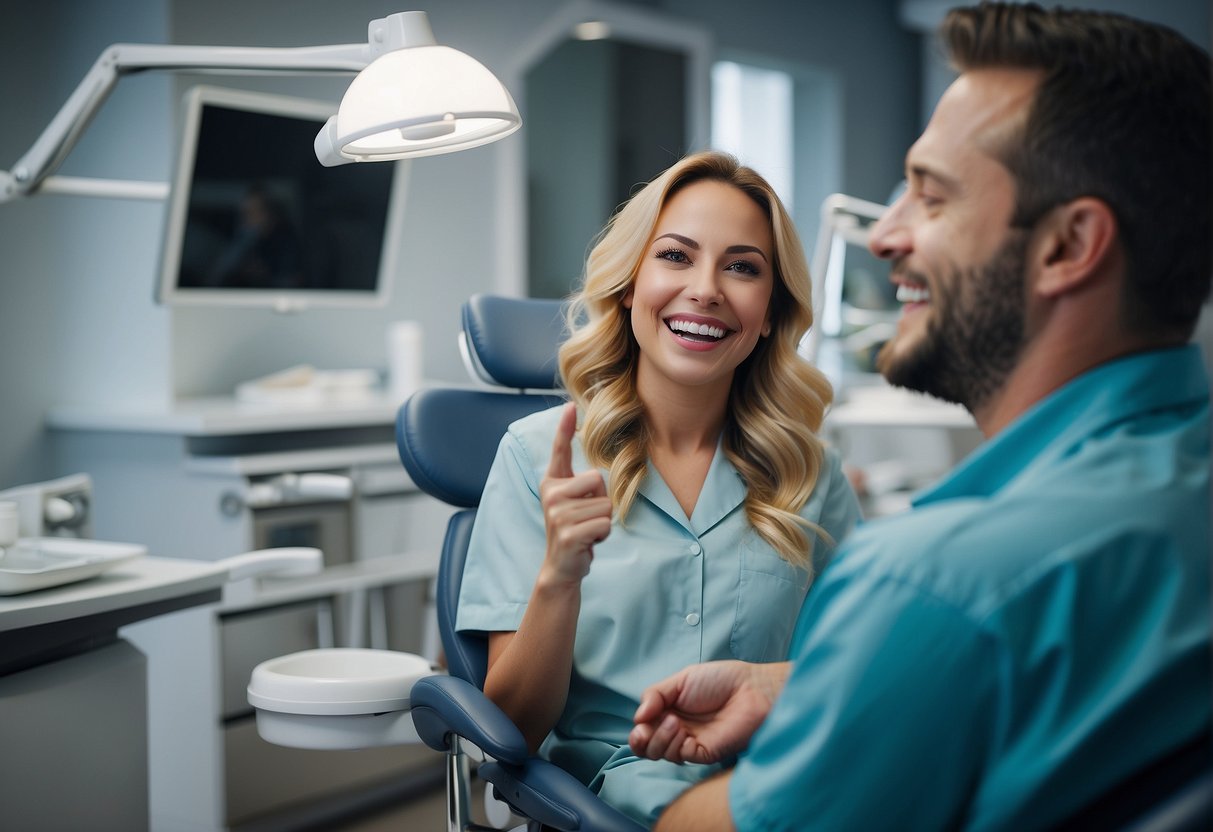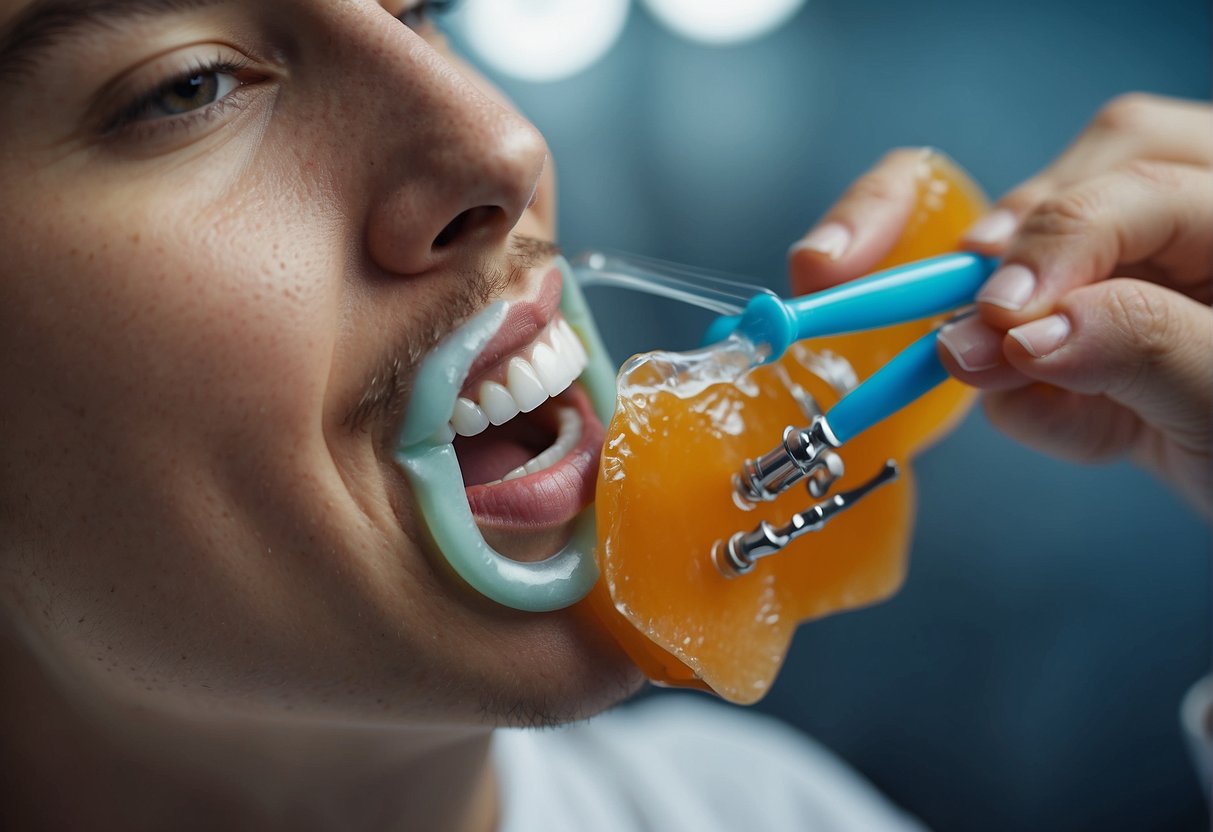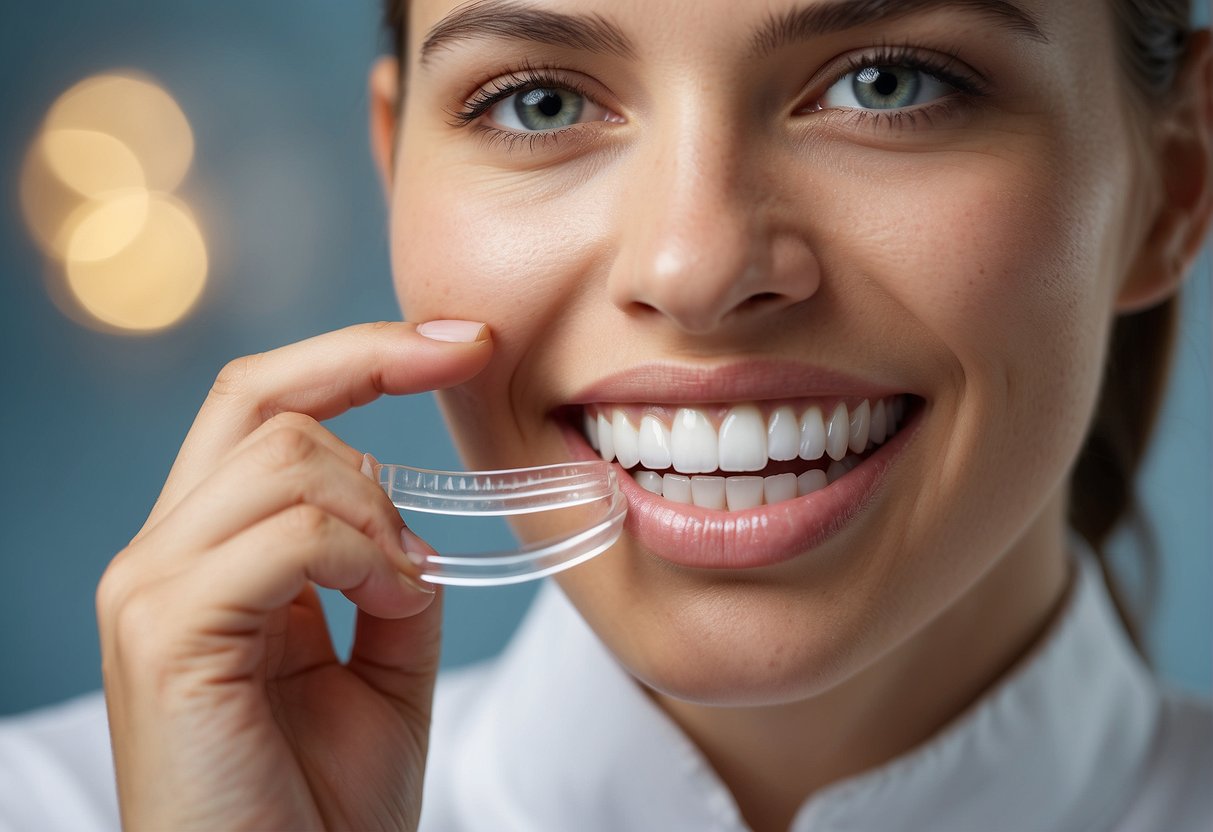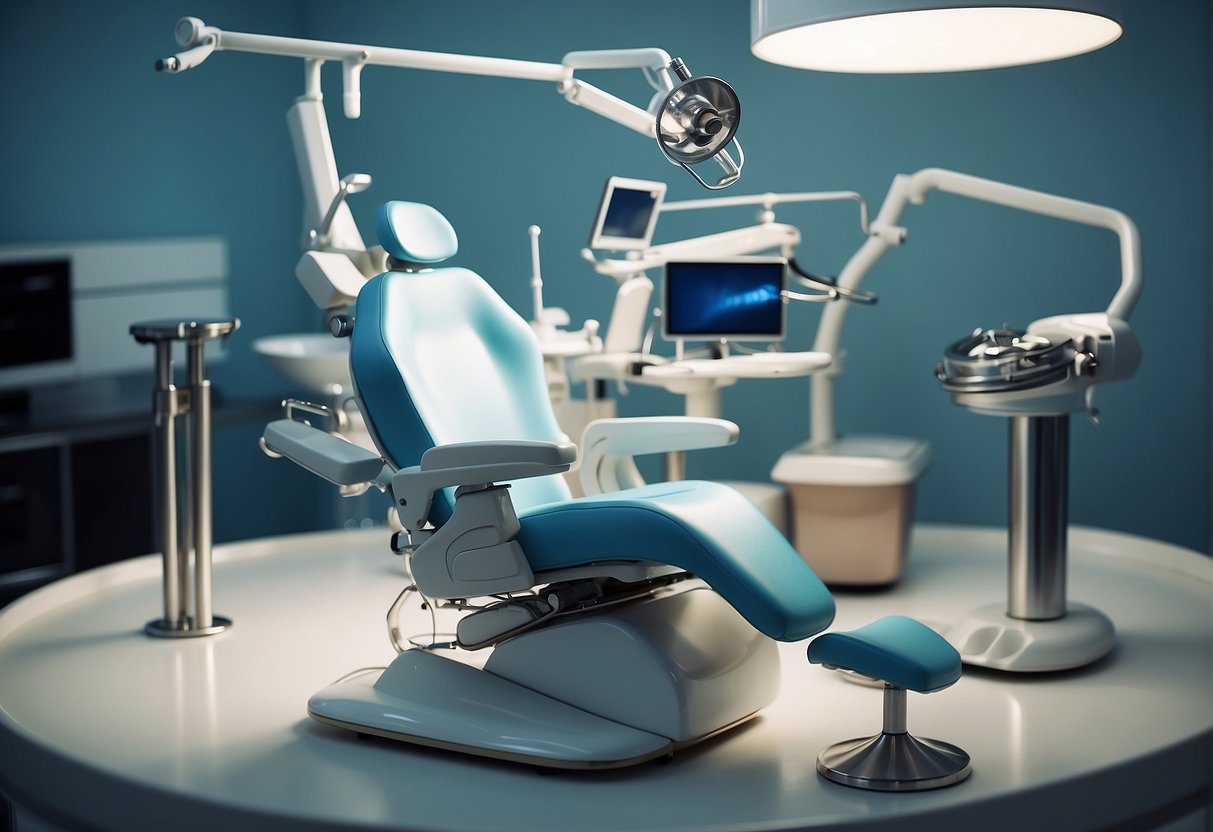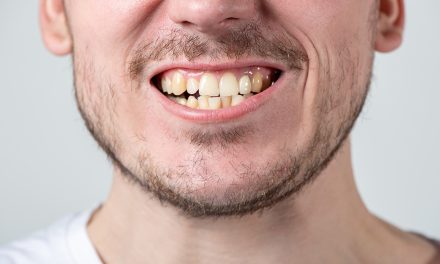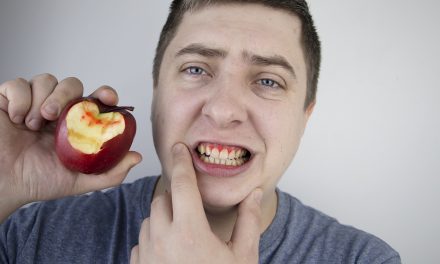Understanding Braces and Teeth Whitening
When an individual has braces, traditional methods of teeth whitening can pose challenges. The brackets and wires of braces obstruct certain areas of the teeth, potentially leading to uneven whitening. Braces are designed for straightening teeth, but they don’t prevent discoloration from occurring. Therefore, maintaining oral hygiene is crucial to prevent staining while undergoing orthodontic treatment.
Methods and Precautions: Those with braces can still pursue teeth whitening, but they need to choose methods that avoid the braces. For example, whitening toothpaste can be effective as it does not interfere with braces and can remove surface stains gradually. It’s important to select toothpaste with a gentle formula to avoid damaging the enamel or orthodontic appliances.
In-Office Treatments: Dental professionals may provide treatments that can work around the braces. These procedures must be done with caution to prevent uneven whitening.
| Do | Don’t |
|---|---|
| Use a soft-bristled toothbrush. | Use whitening strips or trays while braces are on. |
| Floss daily to remove plaque and discoloration. | Apply at-home bleaching products to teeth with braces. |
| Consider whitening mouthwashes. | Ignore the manufacturer’s and dentist’s instructions. |
Diet also plays a critical role in maintaining white teeth with braces. They should avoid foods and beverages that are known to cause stains, such as coffee, tea, wine, and berries. After the orthodontic treatment is completed and the braces are removed, individuals have more options for whitening treatments, including professional bleaching or over-the-counter whitening strips that could provide more uniform results.
Pre-Treatment Assessment
Before attempting to whiten teeth with braces, it is crucial to undergo a thorough pre-treatment assessment to ensure the safety and effectiveness of the whitening process.
Dental Check-Up
A dental check-up is essential to evaluate oral health. The dentist will examine the teeth and gums for any signs of decay, gum disease, or other issues that could affect the whitening process. If necessary, restorative work should be prioritized before cosmetic procedures.
Identifying Stains
The nature and origin of stains on the teeth will be assessed. Stains can be extrinsic (surface stains) or intrinsic (within the tooth structure). Braces can complicate stain removal, thus identifying the type of stains will inform the choice of whitening technique.
Setting Expectations
It is important to have realistic expectations about teeth whitening results with braces. The dentist will provide a clear picture of possible outcomes and limitations to avoid dissatisfaction with the final result. They will also discuss maintenance post-whitening to sustain the achieved brightness.
Choosing a Whitening Method
When selecting a whitening method with braces, it’s critical to find options that are both safe and effective. Braces can complicate the whitening process, so the chosen method should accommodate the brackets and wires without causing damage.
Whitening Toothpaste
Whitening toothpastes are a common choice for maintaining oral hygiene and gently removing surface stains. They contain mild abrasives and chemicals that can brighten teeth:
- Safety: Generally safe for use with braces, as it does not interfere with brackets or wires.
- Effectiveness: Offers gradual whitening and may take longer to see results compared to other methods.
Whitening Strips
One must be cautious with whitening strips when wearing braces. The strips should not be placed on the brackets, as they only whiten the exposed tooth surfaces, which could result in uneven coloring:
- Safety: May not be suitable for those with braces because of the potential for uneven whitening.
- Effectiveness: Can be effective on the exposed areas, but overall results might be inconsistent due to the braces.
Professional Whitening
Professional whitening by a dentist is a consideration for individuals with braces who are looking for more dramatic results. Dental professionals can customize treatments to work around braces:
- Safety: High, as the treatment is administered by a professional who can accommodate braces.
- Effectiveness: Typically more effective and quicker than at-home methods, but requires consultation with an orthodontist.
Daily Oral Hygiene Routine
Maintaining daily oral hygiene is crucial for those with braces to prevent staining and ensure teeth whitening efforts are effective. The routine involves specific brushing techniques, flossing methods adapted for braces, and proper rinsing practices.
Brushing Techniques
One should brush their teeth with a soft-bristled toothbrush and fluoride toothpaste for two minutes, at least twice a day. It’s essential to brush gently but thoroughly, covering all surfaces of the teeth and braces. Angle the brush at 45 degrees to clean the spaces between the braces and the gums.
- Top Surface: Brush downwards on the upper teeth.
- Bottom Surface: Brush upwards on the lower teeth.
- Brackets: Clean each bracket with a proxabrush or an orthodontic brush.
Flossing with Braces
Flossing daily is indispensable for oral health, especially with braces, as particles can become trapped more easily. One should use waxed floss or a floss threader to navigate the floss behind the wires of their braces effectively.
- Floss Threaders: Use these tools to pull the floss through the teeth above the wire.
- Waxed Floss: It’s less likely to catch on the braces and easier to slide between teeth.
Rinsing Practices
After brushing and flossing, one should rinse their mouth to remove any loosened particles. An antiseptic or fluoride mouthwash can help kill bacteria and strengthen teeth.
- Rinsing Steps:
- Take a mouthful of rinse.
- Swish vigorously for 30 seconds.
- Spit out the rinse without swallowing.
Avoiding Staining Foods and Habits
Maintaining white teeth with braces involves careful attention to what one consumes and the lifestyle choices they make. Below are specific strategies to help prevent stains.
Dietary Considerations
Foods to Avoid:
- Coffee and Tea: Regular consumption can lead to staining.
- Soda and Colored Beverages: Dark sodas and certain fruit juices can discolor teeth.
- Berries: Blueberries, blackberries, and other deeply colored berries have staining properties.
- Sauces: Soy sauce, balsamic vinegar, and tomato sauce can also cause stains.
Foods to Enjoy:
- Water: Rinse with water after eating to reduce potential stains.
- Milk and Cheese: They help to strengthen teeth and do not stain braces.
- Crunchy Vegetables: Carrots and celery can help clean teeth naturally.
Lifestyle Changes
Habits to Discourage:
- Smoking: Tobacco causes significant staining and is detrimental to oral health.
- Chewing Gum: Some gums have coloring agents that can stain braces.
- Neglecting Oral Hygiene: Inadequate brushing and flossing allow stains to set in.
Habits to Adopt:
- Regular Oral Hygiene: Brushing and flossing after meals reduces the risk of stains.
- Routine Dental Visits: Professional cleanings assist in maintaining teeth whiteness.
- Straws: When consuming staining liquids, use straws to bypass the teeth and braces.
Safe Home Remedies
While wearing braces, maintaining oral hygiene and keeping teeth white can be challenging. The following home remedies can be effective, but they should be used with caution to avoid damaging the braces or the health of the teeth and gums.
Baking Soda Solutions
Baking soda, also known as sodium bicarbonate, has natural whitening properties and can be used as a gentle abrasive to help remove surface stains on teeth. The use of baking soda with braces should be careful to prevent any harm to the orthodontic work.
- Method: Mix a small amount of baking soda with water to create a paste.
- Application: Apply the paste to a soft-bristled toothbrush and brush gently around the brackets and wires.
- Frequency: Limit the use to once a week as overuse can cause enamel erosion.
Hydrogen Peroxide Use
Hydrogen peroxide is well-known for its bleaching and disinfectant properties, making it another option for teeth whitening at home. It can help in killing bacteria and whitening teeth without applying hard substances on the tooth’s surface.
- Method: Dilute hydrogen peroxide with water (equal parts) to make a mouthwash.
- Application: Swish the solution around the mouth for about 30 seconds, then spit it out.
- Frequency: Use up to twice a week to reduce the risk of sensitivity and irritation.
It’s essential to follow these methods with proper oral hygiene practices, such as regular brushing and flossing, to achieve and maintain the best results. Consulting with an orthodontist before trying new home remedies is also recommended to ensure compatibility with braces.
Dealing with Braces Discoloration
When wearing braces, maintaining the color of your teeth is a unique challenge, but with the right practices and products, discoloration can be effectively managed.
Regular Adjustments
Having regular orthodontic appointments is essential for maintaining braces. These adjustments don’t just ensure optimal teeth alignment; they also allow orthodontists to address any emerging discoloration issues. During visits, they can:
- Replace discolored ties.
- Remove any plaque buildup around brackets.
- Recommend specialized cleaning routines tailored to the patient’s needs.
Brace-Friendly Whitening Products
It’s critical to choose teeth whitening products that are safe for use with braces. Non-abrasive toothpaste and fluoride mouthwash are effective and can be used daily. For targeted whitening, one might consider:
- Whitening toothpastes: Specifically designed for braces and will not damage brackets.
- Whitening rinses: To be used as part of the daily oral hygiene routine, offering gradual and gentle whitening.
Professional Dental Cleanings
Regular professional dental cleanings play a vital role in maintaining oral hygiene, especially for individuals with braces. Dental professionals use specialized tools to remove plaque and tartar buildup that one might miss during regular brushing and flossing.
- Pre-Cleaning Examination: A dental hygienist typically starts with an examination of the patient’s teeth and braces, looking for areas that require special attention.
- Scaling and Polishing: Dental scaling involves scraping away plaque and tartar around the gum line and on the brackets and wires. Polishing follows to remove stains and any remaining plaque, leaving teeth smoother and reducing future plaque buildup.
- Interproximal Cleaning: Hygienists often use interdental brushes or floss threaders to clean between teeth and around braces, which are common areas for plaque accumulation.
- Fluoride Treatment: After cleaning, a fluoride treatment may be applied to strengthen teeth and prevent cavities. Fluoride is especially important for those with braces, as it can help combat demineralization that sometimes occurs around brackets.
Patients should ensure they schedule professional dental cleanings every six months—or more frequently if recommended by their dentist. These regular visits are crucial for keeping teeth and gums healthy and can make the orthodontic treatment process smoother and more effective.
Post-Braces Teeth Whitening
Once braces are removed, a patient may find that their teeth have uneven coloring. Post-braces teeth whitening can help achieve a more uniform and brighter smile.
Whitening After Braces Removal
After orthodontic treatment, teeth may exhibit differences in color due to uneven wear, plaque accumulation, or the presence of adhesive residue. It’s essential to allow the enamel to re-mineralize for at least one month before starting any whitening treatment to avoid sensitivity and to ensure the most effective results.
Options for Post-Braces Whitening:
- Professional Whitening: A dentist can provide in-office whitening treatments, which typically use higher concentrations of bleaching agents. This option offers immediate results but should be undertaken with professional guidance.
- At-Home Whitening Kits: These are available over the counter and include strips, gels, or trays with bleaching agents. Usage must follow the product’s instructions to avoid damaging the recently liberated teeth.
- Whitening Toothpaste: Daily use of whitening toothpastes can gradually remove surface stains and improve overall tooth color. The products chosen should be gentle to not harm the enamel.
- Natural Remedies:
- Baking soda and hydrogen peroxide can be used sparingly to create a paste for gentle stain removal.
- Eating crunchy fruits and vegetables might help in naturally scrubbing the tooth surface.
Dental professionals recommend waiting a minimum of one month post-braces before beginning any form of whitening treatment. One should consult with their orthodontist or dentist for personalized advice and to choose the most suitable whitening method.
Monitoring Progress and Touch-ups
When whitening teeth with braces, it’s crucial to track progress and recognize when touch-ups are necessary. This ensures that the whitening process is effective and that your teeth remain healthy throughout the treatment.
Regular Dental Visits
An individual must schedule dental appointments every six months, or more frequently if advised by their orthodontist. During these visits, the dentist can assess the progress of teeth whitening and identify any uneven spots or areas that may require additional attention. It is imperative to follow the dentist’s guidance on how to proceed with touch-ups to maintain consistent whitening across all teeth.
- Dental Check-up Interval: 6-month basis (or as recommended)
- Purpose of Visits:
- Assess whitening progress
- Ensure even coloring
- Guidance on touch-ups
At-Home Monitoring
Regular self-monitoring at home is an important facet of teeth whitening maintenance with braces. Individuals should use a mirror in well-lit conditions to inspect their teeth. They should specifically look for signs of uneven whitening or areas behind the braces that may have been missed. If discrepancies in coloration are noted, the individual should consult their orthodontist for advice on how to address these areas safely and effectively.
- Self-Monitoring Tools:
- A handheld mirror
- Adequate lighting conditions
- Self-Monitoring Signs to Look For:
- Uneven whitening
- Missed spots behind braces
Potential Risks and Side Effects
When attempting to whiten teeth with braces, it is important for one to be aware of possible challenges. Whitening procedures with braces in place can lead to issues such as tooth sensitivity and gum irritation.
Tooth Sensitivity
After a whitening treatment, individuals may experience increased sensitivity in their teeth. This can be temporary but is a common side effect due to the bleaching agents interacting with the enamel and possibly the dentin. Key factors include:
- Concentration of bleach: Higher concentrations lead to greater sensitivity.
- Duration of exposure: Longer treatment times can exacerbate sensitivity.
Gum Irritation
Gum irritation often results from the bleaching agents coming into contact with the soft tissue of the gums. One may notice:
- Redness or inflammation of the gums
- Discomfort or a mild burning sensation
Proper application techniques and protective measures, such as using a gingival barrier, can help reduce the risk of gum irritation.
Product Recommendations
Choosing the right products is essential for maintaining oral hygiene and achieving teeth whitening results while wearing braces.
Whitening Products for Braces
Braces wearers should look for whitening products specifically designed for use with orthodontic appliances. These products include:
- Whitening Toothpastes: Toothpastes that are safe for braces, such as those with lower abrasivity levels, can gently remove surface stains.
- Example: OrthoFoam Braces Whitening Toothpaste.
- Remineralizing Gels: Gels high in fluoride or calcium phosphate can help maintain tooth enamel health while whitening.
- Example: EverSmile WhiteFoam.
General Oral Care Products
Apart from whitening-focused items, maintaining overall oral cleanliness is crucial, and these products can help:
- Water Flossers: A user-friendly alternative to traditional floss that can clean around brackets and wires efficiently.
- Example: Waterpik Aquarius Water Flosser.
- Interdental Brushes: Small brushes to remove plaque and food particles in areas around the braces where a regular toothbrush might not reach.
- Example: TePe Interdental Brushes.
Frequently Asked Questions
Whitening teeth with braces requires careful consideration to ensure both safety and effectiveness. This section answers common questions about teeth whitening methods suitable for braces wearers.
What are safe methods for whitening teeth while wearing braces?
Individuals with braces should consider using a whitening toothpaste or mouthwash specifically designed for orthodontic use. Consultation with an orthodontist is advisable before starting any whitening treatment to avoid damaging the braces or teeth.
How can baking soda be used to whiten teeth with braces?
Baking soda can be used to gently brush teeth with braces. It’s recommended to make a paste with water and softly apply it using a toothbrush with soft bristles. One must carefully clean around the brackets and wires to avoid harm.
Are whitening strips a viable option for those with braces?
Whitening strips are generally not recommended for use with braces as they cannot whiten beneath brackets and may lead to uneven coloring. It is crucial for braces wearers to wait until their orthodontic treatment is completed before considering strips for whitening.
What is the best whitening toothpaste recommended for braces wearers?
Braces wearers should look for whitening toothpaste that contains fluoride and is labeled as compatible with orthodontic care. Products that carry the American Dental Association (ADA) Seal of Acceptance are often recommended by dental professionals.
How can yellow stains be removed from teeth with braces?
To remove yellow stains, maintain a strict oral hygiene regimen that includes brushing with quality toothpaste after every meal, flossing daily with an orthodontic flosser, and using an antibacterial mouthwash. Regular cleaning by a dental professional is also crucial.
What are the procedures for whitening teeth after braces are removed and what can I expect in terms of cost?
Once braces are removed, in-office bleaching or at-home bleaching kits are common procedures for whitening teeth. Costs vary widely based on geographic location and specific treatment options, ranging from $300 to $800 for professional treatments and $20 to $100 for at-home kits.
Conclusion
In conclusion, achieving a brighter smile while wearing braces is entirely possible with the right approach and consistent care. It’s essential to maintain good oral hygiene by brushing with a fluoride toothpaste, flossing regularly, and using an interdental brush to remove any trapped food particles. Incorporating foods that naturally scrub your teeth, like apples and carrots, can also aid in keeping your teeth clean. Additionally, avoiding substances that can stain your teeth, such as coffee, tea, and red wine, is crucial for preventing discoloration.
For those looking for more intensive whitening, it’s advisable to consult with an orthodontist before using any whitening products to ensure they are safe and won’t damage the braces or the teeth. Over-the-counter options like whitening toothpaste and mouthwashes can be used, but it’s important to select products specifically designed for use with braces. Professional treatments should be postponed until after the braces are removed to achieve the most uniform results.
Ultimately, patience is key when trying to whiten teeth with braces. While it may take a bit longer to see results compared to those without braces, with diligent care and the right techniques, you can still work towards a brighter, healthier smile that will shine through once the orthodontic treatment is complete. Remember that the primary goal while wearing braces is to straighten the teeth, and a beautiful, white smile can be more easily achieved once they’re removed and the teeth are properly aligned.

